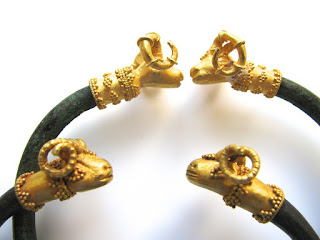When describing jewelry connoisseur and collector Patti Cadby Birch the term world traveler scarcely does her justice. For Birch did not just travel the world, she immersed herself in it.
Patti was born in 1923 to an American father and Russian mother living in New York. During her youth Patti traveled the world and spent her formative years of study mainly in Paris. After completion of her schooling abroad, she returned to the U.S. and briefly enrolled in the University of Virginia. Her love of art soon lured her to the Philadelphia Museum of Art where she worked under the guidance of David Rosen. This meaningful employment was to become the entrance into a world that became her life’s journey.
In 1952, she met and married Everett B. Birch. Her love of art and travel flourished. The couple became avid collectors and in the early 1950s Patti, opened Cadby Birch Gallery to further enrich her interest in fine art. Shows included works by Zoa Wou-Ki, Vuillard, Severini… her collection of contemporary art flourished.
Patti also had a great interest in the ancient and exotic, this took the Birches to Persia and Morocco where they purchased a home in Marrakech. There are currently two rooms at the Metropolitan Museum dedicated to her love of the culture and the memory of Patti.
Birch eventually made her home on the U.S. Virgin Island of St. Thomas where she opened Circe Gallery in 1969. Here she became not only known worldwide for her impressive collection of ancient Persian, African, and Pre-Colombian relics, but also the fine collection of jewelry that was now her passion. Historical Persian jewels delighted her and she made multiple trips to Iran and surrounding areas to acquire ancient beads and jewelry that could either be worn “as is”, or fashioned into wearable artifacts.
 |
| Detail of a Gold and Garnet Bead Necklace, Northern Persia |
When speaking of these jewels, Patti said they “hold one of the keys to understanding by-gone civilizations.” During this time she also designed an affordable line of jewelry, mainly in silver, under the Circe label that echoed the handiwork of the ancient pieces.
Birch’s collection of ancient Persian jewelry has been featured in some of the world’s most prominent museums, including “Jewelry from Persia” at Germany’s renowned Schmuckmuseum Pforzheim and “Ornaments of the East” at The Hermitage Museum in Saint Petersburg, Russia.
 |
| Detail of Ancient Beads |
Patti Cadby Birch remained devoted to the art world throughout her life. She served on both the Board of the Museum of Modern Art as well as that of the Metropolitan Museum. She helped organize numerous exhibitions, gave artists their first shows and brought to life ancient worlds.
Kimberly Klosterman Jewelry is very excited to share several Patti Cadby Birch pieces in our collection.
|
|
|
|
| |
|
|
|
 |
| 1st Century BC - 1st Century AD Necklace Northern Persia |
 |
| 6 - 7th Century AD Sasanian Pendant with Modern Garnet Additions and Early Crystal Beads |





























.jpg)

.jpg)
.jpg)










